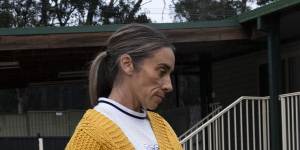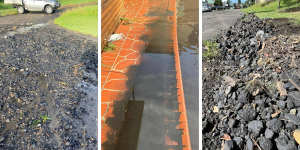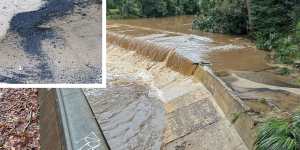When she arrived home to Russell Vale in the Illawarra on Saturday morning,she found her property and the entire township blanketed with lumps of coal.

Kristy Lakeman next to her pool,which is still black with coal dust,at her Russell Vale home.Louise Kennerley
“There was coal all over the road - you wouldn’t have been able to get through the road unless you had a four-wheel-drive,” Lakeman said. “It was blocking all of the gutters and the drains,and it was all over our front grass,all through our backyard,and in our pool,it was just everywhere.”
The Illawarra was hit by 194.8 millimetres of rain on Saturday and 35.4 millimetres the previous day as a weather system moved from Queensland down the NSW coast,Bureau of Meteorology records show. The extreme weather was in line with the expectations of scientists that rather than drawn-out drizzle.
The escarpment is riddled with current and former coal mines that have struggled with the deluge,sending coal into properties and also the Hacking River in the Royal National Park,where platypuses were. The area also has water catchments that provide some of Sydney’s drinking water.
There are serious concerns about whether the owner of Russell Vale Colliery – the mine neighbouring Lakeman’s property – has enough money for remediation in the event of permanent closure.

The mine is owned by Wollongong Resources and ultimately Indian company Jindal Steel and Power. The local company was delisted from the Australian Securities Exchange in 2020 with over $1 billion in debt.
The Russell Vale mine was closed temporarily by the regulator in January. Wollongong Resources has made workers redundant and a spokesperson said it is assessing whether to permanently close the mine and nearby Wongawilli Colliery.
The NSW Resources Regulator holds $12.34 million in security for remediation of Russell Vale and $40.15 million for Wongawilli,which it said was sufficient. However,in 2020,the mine owner estimated the cost of rehabilitating the Russell Vale site was $215 million.
Minister for Natural Resources Courtney Houssos told a budget estimates inquiry earlier this year she would ensure those obligations were honoured,and the mine was rehabilitated.

Residents’ photos of coal waste strewn through the township of Russell Vale on Saturday.Supplied
The Sydney Morning Herald spoke to several people in Russell Vale,who said the last time coal washed into the town was in the 1990s.
Lakeman said it was “pretty terrible” that the community was left to organise its own clean-up on the weekend. She said a mine representative told her husband they would clear the public road,but they were not responsible for cleaning up private properties.
“For two days,everyone in the street was cleaning up coal - we had our 12-year-old son digging and picking up coal for two days,and[my husband’s] 84-year-old granddad was out there shovelling coal too,” she said. “Clearly they don’t really care.”
A Wollongong Resources spokesperson said he spoke to every resident who was home on Saturday morning,but he did not recall the details of every conversation. He only had a skeleton staff on the weekend,and he could not organise a crew to help clean up private properties until Monday.
He said the mine did not have any coal stored on the ground,but the site was over 100 years old and there must have been loose coal further up the slope carried by a landslide.
An Environment Protection Authority spokesperson said it was satisfied with the clean-up.
During the same rain event,Metropolitan Collieries near Helensburgh,owned by Peabody Energy,also washed discharge into Camp Gully Creek and the Hacking River in the national park.

An EPA spokesperson said the mine had two of its four monitoring systems washed away,and discharge from a spillway flowed into the creek. EPA officers inspected the mine,the creek and the river on Saturday and Monday and found “no obvious impacts”,but did find coal deposits in both waterways that “appears to be historical coal washed downstream by the intense weather event”.
Bob Crombie,a former senior national park ranger now with Sutherland Shire Environment Centre,said he went up the river on the weekend and found coal fines about a centimetre thick at the edge of the sand sediment on the upper causeway.

Coal waste at the upper causeway of the Hacking River in the Royal National Park,downstream from Metropolitan Collieries,over the weekend. Sutherland Shire Environment Centre.
A Peabody spokesperson acknowledged some of its monitoring systems washed away,but the context was a natural disaster that “tore up roads,washed away cars,closed rail lines and ruined homes and community infrastructure”,and the company complied with its obligations.
Last month,the company pleaded guilty in the NSW Land and Environment Court to three charges associated with pollution incidents in September and October 2022,and the EPA dropped two other charges.
Associate Professor Ian Wright,who specialises in environmental science at Western Sydney University,said the coal litter at Russell Vale was unsightly,but the coal fines in the Hacking River had a more serious ecological impact. It created a “black,treacle-like layer” at the bottom of the river that strangled the invertebrates that are food for fish,lizards,frogs,and platypuses.
Platypuses can usually survive floods,but the researchers behind the platypus translocation project won’t know how the animals - or their tracking equipment - fared during the extreme weather until later this week.
Sutherland Shire Environment Centre spokesperson Catherine Reynolds said the Metropolitan mine’s monitoring systems failed when they were needed most. “If they can’t operate a mine under these conditions,they shouldn’t operate a mine in that location,” she said.
Wright said the escarpment was naturally fragile and prone to landslides. He added the big risk from so many current and former mines in the area was that subsidence could poison the drinking water catchments.
Get to the heart of what’s happening with climate change and the environment.